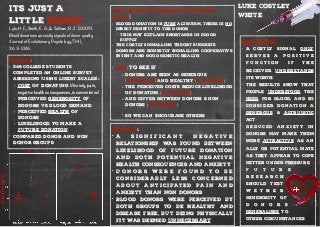PDF Blood Donation Costly Signalling
•
0 gostou•129 visualizações
Denunciar
Compartilhar
Denunciar
Compartilhar
Baixar para ler offline

Recomendados
Recomendados
More than Just Lines on a Map: Best Practices for U.S Bike Routes
This session highlights best practices and lessons learned for U.S. Bike Route System designation, as well as how and why these routes should be integrated into bicycle planning at the local and regional level.
Presenters:
Presenter: Kevin Luecke Toole Design Group
Co-Presenter: Virginia Sullivan Adventure Cycling AssociationMore than Just Lines on a Map: Best Practices for U.S Bike Routes

More than Just Lines on a Map: Best Practices for U.S Bike RoutesProject for Public Spaces & National Center for Biking and Walking
Mais conteúdo relacionado
Destaque
More than Just Lines on a Map: Best Practices for U.S Bike Routes
This session highlights best practices and lessons learned for U.S. Bike Route System designation, as well as how and why these routes should be integrated into bicycle planning at the local and regional level.
Presenters:
Presenter: Kevin Luecke Toole Design Group
Co-Presenter: Virginia Sullivan Adventure Cycling AssociationMore than Just Lines on a Map: Best Practices for U.S Bike Routes

More than Just Lines on a Map: Best Practices for U.S Bike RoutesProject for Public Spaces & National Center for Biking and Walking
Destaque (20)
Content Methodology: A Best Practices Report (Webinar)

Content Methodology: A Best Practices Report (Webinar)
How to Prepare For a Successful Job Search for 2024

How to Prepare For a Successful Job Search for 2024
Social Media Marketing Trends 2024 // The Global Indie Insights

Social Media Marketing Trends 2024 // The Global Indie Insights
Trends In Paid Search: Navigating The Digital Landscape In 2024

Trends In Paid Search: Navigating The Digital Landscape In 2024
5 Public speaking tips from TED - Visualized summary

5 Public speaking tips from TED - Visualized summary
Google's Just Not That Into You: Understanding Core Updates & Search Intent

Google's Just Not That Into You: Understanding Core Updates & Search Intent
The six step guide to practical project management

The six step guide to practical project management
Beginners Guide to TikTok for Search - Rachel Pearson - We are Tilt __ Bright...

Beginners Guide to TikTok for Search - Rachel Pearson - We are Tilt __ Bright...
Unlocking the Power of ChatGPT and AI in Testing - A Real-World Look, present...

Unlocking the Power of ChatGPT and AI in Testing - A Real-World Look, present...
More than Just Lines on a Map: Best Practices for U.S Bike Routes

More than Just Lines on a Map: Best Practices for U.S Bike Routes
Ride the Storm: Navigating Through Unstable Periods / Katerina Rudko (Belka G...

Ride the Storm: Navigating Through Unstable Periods / Katerina Rudko (Belka G...
PDF Blood Donation Costly Signalling
- 1. Its just a little blood Lyle, H. F., Smith, E. A., & Sullivan, R. J. (2009). Blood donations as costly signals of donor quality. Journal of Evolutionary Psychology, 7(4), 263-286. Why do we give blood in the first place? • Blood donation is pure altruism, there is NO direct benefit to the donor • This may explain shortages in blood supply • The Costly Signalling Theory suggests donors are honestly signalling cooperative intent and good genetic health ! • AIM:to see if - • donors are seen as generous (supported) and healthy (supported) • the perceived costs reduce likelihood of donating (supported) • and differ between donors & non donors (supported) ! • so we can encourage others MEthod: • 346 college students completed an online survey assessing (using likert scales): • Cost of donating (Anxiety, pain, negative health consequences, inconvenience) • Perceived generosity of donors vs blood demand • perceived health of donors • Likelihood to make a future donation • Compared donor and non donor groups Results: • a s i g n i f i c a n t n e g at i v e relationship was found between likelihood of future donation and both potential negative health consequences and anxiety • D o n o r s w e r e f o u n d t o b e considerably less concerned a b ou t a n t ic i pat e d pa i n a n d anxiety than non donors • Blood donors were perceived by both groups to be healthy and disease free, but being physically fit was deemed unnecessary Discussion: • A costly signal only s e r v e s a p o s i t i v e f u n c t i o n i f t h e receiver understands its worth • The results show that people understood the need for blood, and so consider donation a generous & altruistic act • R e du c e d a n x i e t y i n donors may make them more attractive as an ally or potential mate as they appear to cope better under pressure • f u t u r e r e s e a r c h should test w e t h e r generosity of d o n o r s generalises to other circumstances Luke Costley White
